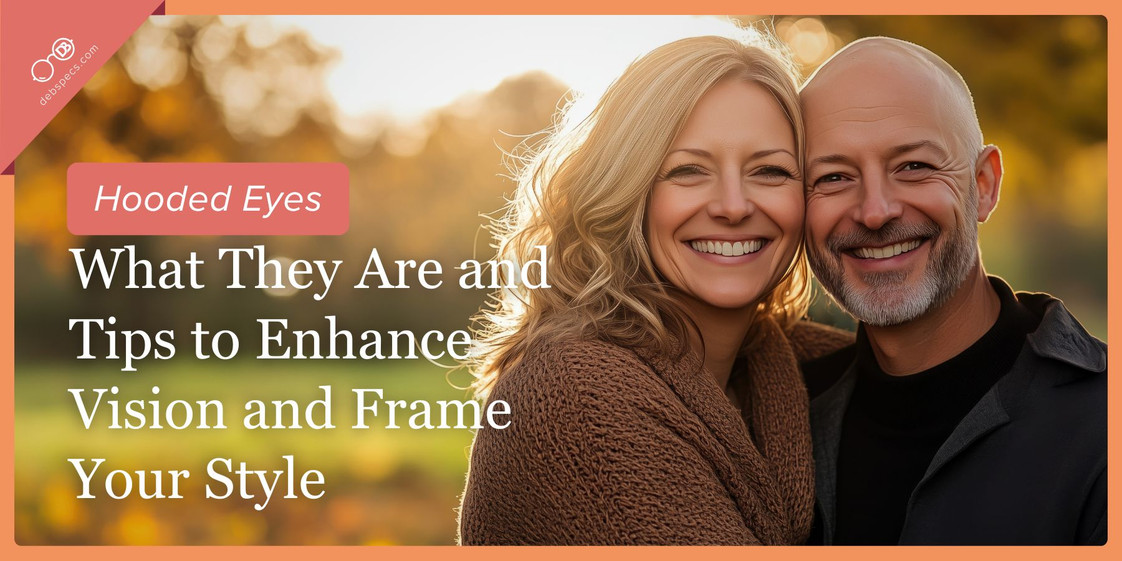
Hooded Eyes: Causes, Makeup Tips, and Solutions (Friendly Guide)
Posted by Team Debby on 20th Jul 2025
Have you noticed your eyelids looking heavier, or your eyeshadow disappearing the moment you open your eyes? You may have what’s called hooded eyes — a completely normal eye shape shared by many women (including Blake Lively, Jennifer Lawrence, and Emma Stone).
If you’re over 40, changes in your eyelids are especially common. But here’s the truth: hooded eyes are beautiful, expressive, and easy to enhance with a few clever makeup tricks and flattering eyewear.
What Exactly Are Hooded Eyes?
Hooded eyes happen when the skin of the upper eyelid folds down over the crease. This “hood” effect can make the lid less visible when your eyes are open.
- Born with it: Some women naturally have hooded eyes due to genetics.
- Developed over time: Others notice hooding as skin loses firmness with age.
Either way, it’s not something to “fix” unless it affects your vision — or if you’d simply like to explore cosmetic options.
Why Do Hooded Eyes Happen?
- Genetics: Often inherited and common across many ethnic backgrounds.
- Aging: Skin loses elasticity, collagen declines, and brows shift slightly downward.
- Rare medical causes: If hooding appears suddenly or comes with pain, asymmetry, or vision issues, check with a doctor.
How to Tell If You Have Hooded Eyes
Try these quick tests:
- Mirror test: Look straight ahead — does your upper lid fold over your crease?
- Eyeshadow test: Does your eyeshadow vanish when your eyes are open?
- Crease check: If your crease is hidden in a natural gaze, you likely have hooded eyes.
Common Challenges with Hooded Eyes
Makeup frustrations:
- Eyeshadow creases or disappears.
- Eyeliner smudges or looks uneven.
- Mascara often transfers onto the upper lid.
- Standard tutorials don’t always apply.
Practical concerns:
- Severe hooding may sometimes block vision or feel heavy.
Quick Tips for Hooded Eyes
Want fast fixes? Try these:
- ✅ Always use an eyelid primer to prevent creasing.
- ✅ Apply darker shades above your crease so they remain visible.
- ✅ Swap heavy eyeliner for tightlining (lining the upper waterline).
- ✅ Curl lashes and use waterproof mascara to lift and avoid smudges.
- ✅ Hydrate the area daily and protect with SPF.
- ✅ Choose upswept glasses frames (like cat-eyes) to visually lift your eyes.
Everyday Makeup Techniques (In Detail)
- Primer: Your secret weapon for all-day eyeshadow.
- Eyeshadow placement:
- Matte shades where the lid folds.
- A pop of shimmer at the center.
- Darker tones slightly above the crease for lift.
- Eyeliner: Tightlining adds definition without shrinking lid space. A soft powder liner prevents harsh lines.
- Mascara: Focus on lengthening and separating lashes. Waterproof formulas keep lids smudge-free.
Skincare for Hooded Eyes
The skin around the eyes is delicate. Show it some love:
- Apply a gentle moisturizer daily.
- Never skip SPF (UV damage speeds up sagging).
- Try light upward massage to refresh circulation.
Glasses That Flatter Hooded Eyes
Frames can instantly transform your look. If you wear readers, look for styles that lift and open.
- Best picks: Cat-eye frames, angular upswept edges, or lightly arched silhouettes.
- Skip: Heavy, straight-across frames that can emphasize hooding.
[Explore our eyewear guide and shop flattering frames here.]
When to Consider Medical Options
Most women never need treatment. But if vision is blocked or you’d prefer a change, here are common approaches:
Non-surgical:
- Botox: Gently lifts the brows by relaxing muscles.
- Fillers: Restore volume and improve eye contour.
Surgical:
- Blepharoplasty: Eyelid surgery to remove excess skin and fat. Usually outpatient, with long-lasting results.
⚠️ Always consult a board-certified professional before considering medical options.
Myth vs Fact
- Myth: Hooded eyes make you look tired.
- Fact: They’re a natural shape shared by countless celebrities and can be just as bright and beautiful.
- Myth: Only surgery can fix hooded eyes.
- Fact: Makeup, skincare, and the right frames can make a dramatic difference.
Are Hooded Eyes a Health Concern?
Not usually. But if you notice sudden hooding, pain, vision loss, or asymmetry, check with a doctor. It’s better to be safe.
Embrace Your Hooded Eyes
Your eyes tell your story — beautifully. Hooded eyes are alluring, expressive, and 100% yours. Whether you enhance them with smart makeup tricks, flattering eyewear, or medical options, the choice is yours. Confidence is always the best accessory.
TL;DR
- Hooded eyes = upper lid folds over crease (genetics or aging).
- Challenges: disappearing eyeshadow, smudgy liner, mascara transfer.
- Fixes: primer, tightlining, crease-above shadow, waterproof mascara.
- Frames: cat-eye or upswept = instant lift.
- Health: harmless unless sudden, painful, or blocking vision.
FAQs
Are hooded eyes and droopy eyes the same?
No. Hooded eyes involve excess skin folding over the crease, while droopy eyes (ptosis) mean the lid margin drops over the eye itself.
Do hooded eyes get worse with age?
They may become more noticeable as skin loses elasticity, but it varies from person to person.
Can exercises fix hooded eyes?
Not really. Exercises can improve muscle tone, but they don’t eliminate excess skin.
Is makeup or surgery better?
It depends on your goals. Many women find makeup and stylish frames do the trick — surgery is optional, not required.
✨ See clearly. Look stylish. Love your eyes. That’s what we’re about at DebbySpecs.

